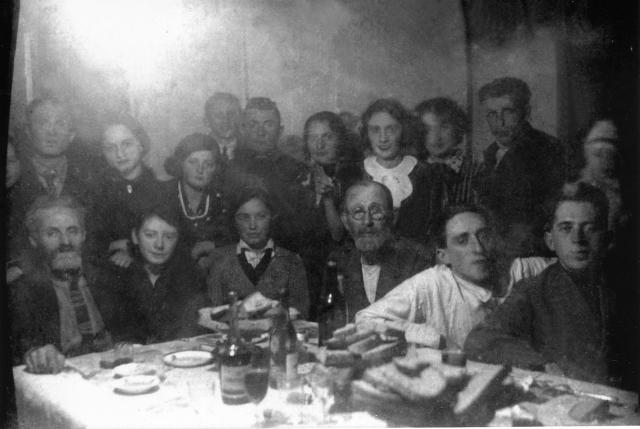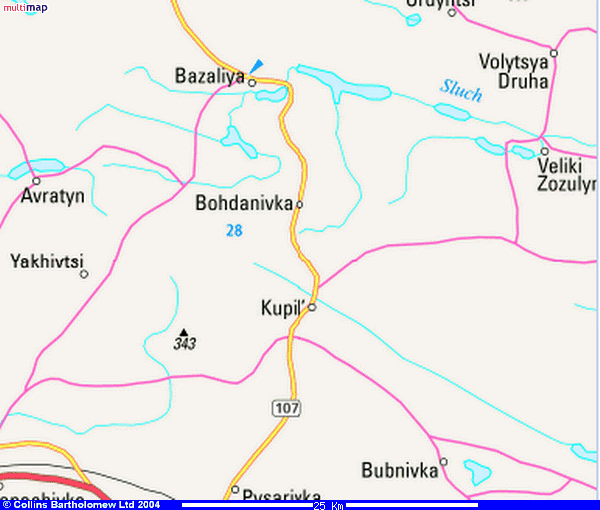Google Maps shows Kupel via the https://goo.gl/maps/DoAL6f6MNLs. There is the view of current Kupel, as it is now. По приведенному выше линку Карты Гугл вы увидите современный Купель, как он есть; дома с большими усадьбами, поля, шоссе... Там нет евреев, нет их домов, ничего не осталось кроме мельницы, в которой теперь больница , а за ней заброшенное, разрушенное еврейское кладбище. Евреев в Купеле нет, а еврейский вопрос? есть...

Евреи Купеля, 1939 г.

Modern Kupel's maps you can find here also:
https://geographic.org/geographic_names/name.php?uni=-1548287&fid=6510&c=ukraine
Page about Kupil in Yahud-In Unum
http://www.holocaustbybullets.com/roadmap/research-trips/research-trip-january-2010/
In 2004, Yahud-In Unum was created to facilitate understanding and collaboration between Catholics and Jews. “Yahad-In Unum” is derived from the word “unity” in both Hebrew and Latin. The founders of YIU were Cardinal-Jean Marie Lustiger, former archbishop of Paris, Cardinal Philippe Barbarin, archbishop of Lyon, Cardinal Jean-Pierre Ricard, archbishop of Bordeaux, Rabbi Israel Singer, former President of the World Jewish Congress, Mr. Serge Cwajgenbaum, secretary-general of the World Jewish Congress and Mr. Pinchas Shapiro. Yahud-In Unum’s largest initiative is an ambitious, multi-year effort to systematically identify and document every single site of Jewish mass execution by Nazi mobile killing units in Eastern Europe during the World War II. The objective of the work is three-fold: to substantiate this “Holocaust by bullets,” to discount Holocaust deniers of today and tomorrow and to give the fallen a respectful burial.
| Research trip, January 2010
Remains of a barn located in the old kolkhoz of Teofipol. (photo © Yahad In Unum / Nicolas Tkatchouk) Staff Patrice Bensimon (interviewer) Svetlana Birioulova (interpreter) Oleksii Kosarevskyi (interpreter) Denis Mouravitski (investigator) Vera Savtchak (interpreter) Thierry Soval (cameraman) Mikhaïl Stroutinski (ballistics expert) Nicolas Tkatchouk (photographer) Manuel Valls-Vicente (report editor) A Yahad-In Unum team completed a research investigation of 17 days in the northern region of Khmelnitski (formerly the Kamenets-Podolsk region), in 12 towns and villages: Pavlikovtsi, Pisarevka, Volotchisk, Kupil, Staraya Siniava, Starokonstantinov, Orlintsi, Manevtsi, Gritsev, Iziaslav, Slavuta and Teofipol. Chmelnitski is part of Podolia, the largest region of modern Ukraine and a region with among the highest numbers of Jewish victims of the Holocaust in Ukraine (over 115,000 deaths). The major points resulting from the trip are discussed below. The camps of Jewish workers of the Durchgangstraße IV (road from Lvov to Dnepropetrovsk via Vinnytsia)
Starokonstantinov, Violida : "The Jews were lined up ten by ten in front of the ditch, there was only one shooter, he was drunk. " (photo © Yahad In Unum / Nicolas Tkatchouk) As in Tarnopol and Lvov, Yahad investigated camps whose primary purpose was the establishment and maintenance of the DG IV. German companies responsible for its maintenance, having insufficient manpower, camps were created along the road for Jewish prisoners forced to perform the most difficult labor for the maintenance work such as working in stone quarries or transporting tombstones. Four of these camps were located in villages Orlintsi, Pavlikovtsi, Volotchisk and Slavuta. Mikhail (born in 1930) of Pavlikovtsi who, as a boy “stole” potatoes from the camp kitchen said: “The Jews worked daily at the sandpit, except in very bad weather. In a line, every Jew threw a shovelful into a moving cart driven in turn by kolkhozien (collective) farmers from surrounding villages. The latter were then directed to the paved road where there were two piles of sand 2.5 m in height. Jews also performed work directly on the road. ” Research has shown that these camps were not cut off from the village: they were located most often in a kolkhoze in the heart of the village, occupying only a part, the other part being operated by non-Jews. Andrei (born 1928) from Orlintsi testified: “The men were separated from women during the night, each occupying a different wing of the building. The children remained locked up during the day, the windows covered with wooden planks. Ukrainians worked in other buildings of the kolkhoze.” The conditions for Jewish prisoners were terrible: “about twenty Jews were forced to pull their own carts.” Fifty of these unfortunates who died of exhaustion or hunger were buried in a pit behind the kolkhoz, which remains unprotected and without memorial. Unlike the camps in DG IV in the Ternopil region, the victims were shot in the town or village outside the camp (Slavuta, Volotchisk, Pavlikovtsi), or in another village (the Jews in the Orlintsi camp were shot at Manevtsi). In this area, the bodies of prisoners of these camps were not subjected to cremation as part of Operation 1005 (the Nazi project to eliminate evidence of their crimes). In addition, investigators noticed that the prisoners of these camps came from very diverse locations Kupel, Krasilov, Bazalia, Volotchisk), indicating the mobility of Jews in this area that the Germans deported according to their needs. Additional research on Starokonstantinov Yahad had begun its research in 2008 in the town of Starokonstantinov, which was more than 50% Jewish at the outset of the war and where between 6,000 and 10,000 Jews were shot. Believing that elements of the investigation into the ghetto and the executions still needed to be clarified, a team returned to investigate and found Violida (born in 1933), who lived just outside the ghetto, and Anna (born in 1929) . They confirmed the information from both the Soviet and German archives: “There was a ghetto in the center, surrounded by telegraph poles connected by barbed wire [...] every Sunday morning, the Jews were gathered at 9:00 in the marketplace. The Germans proceeded with a lengthy roll call and selected a number of individuals with special expertise.“ The team’s research confirmed the information from the archives that there were three shootings, the last in January 1943 in an antitank ditch. Violida said: “The Jews came on a hill, located 300 meters away where the a shooter was waiting. It was the policemen who made them go into the ditich, in groups of 10 people, after being stripped at the top of the hill. They were numb with cold. ” According Violida, the local administration implemented the German orders: “the shooters took turns and were drunk, my neighbor was requisitioned by the staroste (the administrative Ukrainian head of the village) to carry the box of ammunition and alcohol. The staroste also commandeered dozens of villagers to sort the clothing of the Jews and find valuables. Finally, the administration also oversaw the dismantling of Jewish homes in authorizing and announcing their sale to the people of the village and neighboring towns. In 1942, a shooting took place near the train station in a pit dug by the Jews themselves. The father of Zoya (born in 1933), who was Jewish, was then murdered with Roma. However, his mother, a Christian, “like all non-Jewish inhabitants, drew a cross on the door.” Zoya, hidden along the road, had time to say goodbye to his father before he was shot. She survived thanks to a false birth certificate. But also … In the towns of Slavuta and Iziaslav, three witnesses interviewed by Yahad said they had seen gas trucks, which is not mentioned in either the German or Soviet archives. Nikolai (born in 1922) and Petro (born in 1930) from Iziaslav remember that in June 1942 during the liquidation of the ghetto “police officers made the Jews climb into two sealed gas trucks. A pipe of 15-20cm in diameter connected the exhaust pipe to the inside of the truck. “These trucks were going back and forth between the ghetto and place of execution. Meanwhile, other trucks, not sealed, brought other part Jews to be shot. The statements of these witnesses will be the subject of new archival research and will need to be corroborated by researchers. Petro who witnessed the shooting also said that “gas vans had left with people dead or half dead [...] other Jews were shot in the pit. An alley on each side of the pit allowed the shooter to pass. A Staraïa Siniava, a disturbing fact was mentioned by two witnesses Mikhail (1927) and Frank (born in 1927): a Ukrainian woman, the German’s interpreter was present during the shooting and even fired the machine gun at some victims. Here also, the archives do not report this fact. Three witnesses reported the Nazi barbarism in the village of Koupel, where, “about fifty adult men and women were locked in the basement of a building in central Koupel. After several hours, the Germans told the witness to bring water to the survivors. The door was again closed and all died from suffocation. People working on the roads buried the bodies near the entrance, beneath the statue of Lenin.” The bodies were buried in the Jewish cemetery by villagers requisitioned by the Ukrainian police. Finally, thanks to Sergei (born in 1930), the team also located in the village of Teofipol one of the few Jewish kolkhoze buildings still standing in Ukraine or Russia.
Ditch where 50 prisoners from Orlintsi camp were burried. (photo © Yahad In Unum / Nicolas Tkatchouk) Conclusion At the end of the 19th trip to Ukraine, the team had interviewed 56 witnesses and located 14 mass grave sites. Note that in the southern region, unlike other Ukrainian regions, over 80% of the mass grave sites have memorials. However, none is being protected from plunderers. Another trip will be required to complete the investigation in the Khmelnitski region. It will thus have taken four research trips to cover the largest region of Ukraine.
|
|
|